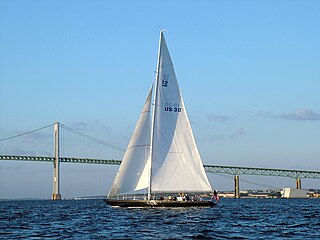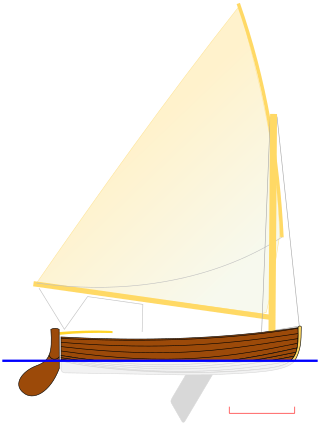
The International 2.4mR is a one-person keelboat. The class is a development class governed by the 2.4mR rule. The rule controlled by World Sailing is one of the few classes designated as an International Class. The International 2.4mR Class rule is closely related to the International 12mR class rule that was used at the America's Cup.
Sailing/Yachting is an Olympic sport starting from the Games of the 1st Olympiad. With the exception of the 1904 and the canceled 1916 Summer Olympics, sailing has always been included on the Olympic schedule. The Sailing program of 1908 was open for a total of five sailing classes (disciplines), but actually only four Sailing events were contested. The planned venue of all races, named matches, was Ryde, Isle of Wight.

The International 5.5 Metre class was created to yield a racing keel boat giving a sailing experience similar to that of the International 6 Metre Class, but at a lower cost.

The International Americas Cup Class is a class of racing yacht that was developed for the America's Cup between 1992 and 2007. These yachts, while not identical, were all designed to the same formula to offer designers the freedom to experiment whilst keeping the boats sufficiently comparable to race in real time. The class was established for the 1992 America's Cup because of perceived shortcomings of the 12-metre class, which had been used in the America's Cup since 1958.

The 12 Metre class is a rating class for racing sailboats that are designed to the International rule. It enables fair competition between boats that rate in the class whilst retaining the freedom to experiment with the details of their designs. The designation "12 Metre" does not refer to any single measurement on the boat, and is not referencing the vessels overall length, rather, measures the sum of the components directed by the formula which governs design and construction parameters. Typically 12 Metre class boats range from 65 to 75 feet in length overall; they are most often sloop-rigged, with masts roughly 85 feet tall.

The J Class of racing yachts were built to the specifications of Nathanael Herreshoff's Universal Rule. The J Class is considered the apex of the era when the Universal Rule determined eligibility in the America's Cup.
The International Offshore Rule (IOR) was a measurement rule for racing sailboats. The IOR evolved from the Cruising Club of America (CCA) rule for racer/cruisers and the Royal Ocean Racing Club (RORC) rule.
The Universal Rule determined a yacht's eligibility to race in the America's Cup from 1914 to 1937 and for this the J-class was chosen. Boats built according to the rule reached their peak in the large J-class yachts. This Rating Rule is intended to calculate a rating for yachts, which can then be used to calculate its Time Correction Factor (T.C.F.) in order to have disparate yachts racing against each other. The first boat said to be built under the universal rule was Herreshoff's Doris built in 1905.

The International rule, also known as the Metre rule, was created for the measuring and rating of yachts to allow different designs of yacht to race together under a handicap system. Prior to the ratification of the International rule in 1907, countries raced yachts under their own national rules and international competition was always subject to various forms of subjective handicapping.

Sailing/Yachting is an Olympic sport starting from the Games of the 1st Olympiad. With the exception of 1904 and the canceled 1916 Summer Olympics, sailing has always been included on the Olympic schedule. The Sailing program of 1912 consisted of a total of four sailing classes (disciplines). For each class two races were scheduled from 19 July 1912 to 22 July 1912 off the coast of Nynäshamn at the Baltic Sea.

The International Six Metre class is a class of classic racing yachts. Sixes are a construction class, meaning that the boats are not identical but are all designed to meet specific measurement formula, in this case International rule. At their heyday, Sixes were the most important international yacht racing class, and they are still raced around the world. "Six metre" in class name does not, somewhat confusingly, refer to length of the boat, but product of the formula; 6mR boats are, on average, 10–11 metres long.

The International Eight Metre class are class of racing yachts. Eight Metre boats are a construction class, meaning that the boats are not identical but are all designed to meet specific measurement formula, in this case International rule. Before WW II, Eights were the most prestigious international yacht racing class and they are still raced around the world. "Eight metre" in class name does not, somewhat confusingly, refer to length of the boat, but product of the formula. 8mR boats are on average some 15 metres long. Between 1907 and 2008 approximately 500 8mR boats were built, 177 of them have survived until today.

The Twelve Foot Dinghy was designed by George Cockshott, an amateur boat designer from Southport, England in response to a 1912 design contest. It became the first one-design racing dinghy to achieve international recognition. The class was granted the 'International' status by the IYRU in 1919 and remained this status until 1964 when it was revoked by the same authority. The class was selected as the dinghy class for the Olympics in 1920 & 1928. In 1924 the French wanted to use an alternate French design.
Ton classes are categories used to identify classes of yachts.

The International Seven Metre Class is a construction class, meaning that the boats are not identical but are all designed to meet specific measurement formula, in this case International Rule. At their heyday, Metre Classes were the most important group of international yacht racing classes, and they are still actively raced around the world. "Seven" in class name does not, somewhat confusingly, refer to length of the boat, but product of the formula; 7mR boats are, on average, 13 meters long.

The International Ten Metre Class is a construction class, meaning that the boats are not identical but are all designed to meet specific measurement formula, in this case International Rule. At their heyday, Metre Classes were the most important group of international yacht racing classes, and they are still actively raced around the world. "Ten" in class name does not, somewhat confusingly, refer to length of the boat, but product of the formula; 10 Metre boats are, on average, 16.5 meters long.
The International Nine Metre Class is a construction class, meaning that the boats are not identical but are all designed to meet specific measurement formula, in this case International Rule. At their heyday, Metre Classes were the most important group of international yacht racing classes, and they are still actively raced around the world. "Nine" in the class name does not, somewhat confusingly, refer to the length of the boat, but the product of the formula; 9mR boats are, on average, 18 meters long.
The International Radio Sailing Association (IRSA) formerly the ISAF Radio Sailing Division is an affiliate member of the International Sailing Federation that sanctions radio-controlled sailing competitions. It is authorised by ISAF to conduct up to three official World Championships each year.

The International B-class/F20 Catamaran, is a development class, on the comeback after the fracturing of the original B-class, into the myriad of one design, off the beach cats we have today.
Handicap forms for sailing vessels in sailing races have varied throughout history, and they also vary by country, and by sailing organisation. Sailing handicap standards exist internationally, nationally, and within individual sailing clubs.
















